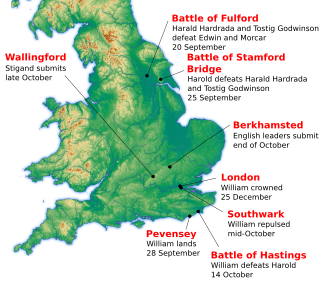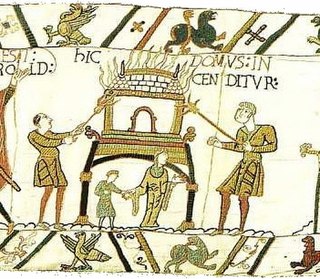Other uses
- International Harvester 1066, a popular tractor model made between 1971 and 1976
1066 is a year in history.

1066 (MLXVI) was a common year starting on Sunday of the Julian calendar.

Harold Godwinson, also called Harold II, was the last crowned Anglo-Saxon English king. Harold reigned from 6 January 1066 until his death at the Battle of Hastings, fighting the Norman invaders led by William the Conqueror during the Norman Conquest of England. His death marked the end of Anglo-Saxon rule over England.
Godwin of Wessex was an English nobleman who became one of the most powerful earls in England under the Danish king Cnut the Great and his successors. Cnut made Godwin the first Earl of Wessex. Godwin was the father of King Harold II and of Edith of Wessex, who in 1045 married King Edward the Confessor.

The Battle of Hastings was fought on 14 October 1066 between the Norman-French army of William, the Duke of Normandy, and an English army under the Anglo-Saxon King Harold Godwinson, beginning the Norman Conquest of England. It took place approximately 7 mi (11 km) northwest of Hastings, close to the present-day town of Battle, East Sussex, and was a decisive Norman victory.

The Battle of Stamford Bridge took place at the village of Stamford Bridge, East Riding of Yorkshire, in England, on 25 September 1066, between an English army under King Harold Godwinson and an invading Norwegian force led by King Harald Hardrada and the English king's brother Tostig Godwinson. After a bloody battle, both Hardrada and Tostig, along with most of the Norwegians, were killed. Although Harold Godwinson repelled the Norwegian invaders, his army was defeated by the Normans at Hastings less than three weeks later. The battle has traditionally been presented as symbolising the end of the Viking Age, although major Scandinavian campaigns in Britain and Ireland occurred in the following decades, such as those of King Sweyn Estrithson of Denmark in 1069–1070 and King Magnus Barefoot of Norway in 1098 and 1102–1103.

The Norman Conquest was the 11th-century invasion and occupation of England by an army made up of thousands of Norman, Breton, Flemish, and French troops, all led by the Duke of Normandy, later styled William the Conqueror.

Gruffydd ap Llywelyn was King of Gwynedd and Powys from 1039 and, after asserting his control over the entire country, claimed the title King of Wales from 1055 until his death in 1063. He was the son of Llywelyn ap Seisyll king of Gwynedd and Angharad daughter of Maredudd ab Owain, king of Deheubarth, and the great-great-grandson of Hywel Dda. Gruffydd was the first and only Welsh king to unite all of Wales albeit for a brief period. After his death, Wales was again divided into separate kingdoms.
Tostig Godwinson was an Anglo-Saxon Earl of Northumbria and brother of King Harold Godwinson. After being exiled by his brother, Tostig supported the Norwegian king Harald Hardrada's invasion of England, and was killed alongside Hardrada at the Battle of Stamford Bridge in 1066.

The Battle of Fulford was fought on the outskirts of the village of Fulford just south of York in England, on 20 September 1066, when King Harald III of Norway, also known as Harald Hardrada, a claimant to the English throne and Tostig Godwinson, his English ally, fought and defeated the Northern Earls Edwin and Morcar.
Gytha Thorkelsdóttir, also called Githa, was a Danish noblewoman. She was the wife of Godwin, Earl of Wessex and the mother of King Harold Godwinson and of Edith of Wessex, who was the queen consort of King Edward the Confessor.
Morcar was the son of Ælfgār and brother of Ēadwine. He was the earl of Northumbria from 1065 to 1066, when William the Conqueror replaced him with Copsi.
Edwin was the elder brother of Morcar, Earl of Northumbria, son of Ælfgār, Earl of Mercia and grandson of Leofric, Earl of Mercia. He succeeded to his father's title and responsibilities on Ælfgār's death in 1062. He appears as Earl Edwin in the Domesday Book.

Gyrth Godwinson was the fourth son of Earl Godwin, and thus a younger brother of Harold Godwinson. He went with his eldest brother Sweyn into exile to Flanders in 1051, but unlike Sweyn he was able to return with the rest of the clan the following year. Along with his brothers Harold and Tostig, Gyrth was present at his father's death-bed.

Leofwine Godwinson was a younger brother of King Harold Godwinson, the fifth son of Earl Godwin.
Events from the 1060s in England.

The House of Godwin is an Anglo-Saxon family who were one of the leading noble families in England during the last fifty years before the Norman Conquest. Its most famous member was Harold Godwinson, King of England for nine months in 1066.
The Treaty of Abernethy was signed at the Scottish village of Abernethy in 1072 by King Malcolm III of Scotland and by William of Normandy.
Godwin or Godwine was a son, probably the eldest son, of Harold Godwinson, King of England. He was driven into exile in Dublin, along with two of his brothers, by the Norman conquest of England, and from there he twice led expeditions to south-western England, but with little success.
Edmund or Eadmundᚪᛖᛞᛘᚩᚾᛞ or Ædmund was a son of Harold Godwinson, King of England. He was driven into exile in Dublin by the Norman conquest of England, along with two of his brothers, and from there he twice took part in expeditions to south-western England, but with little success. He disappears from history in the early 1070s.

The Burning of Southwark was a battle fought in Southwark during the Norman Conquest of England in October 1066.